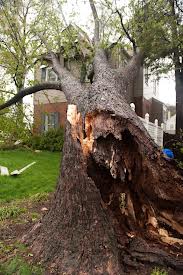 Every year trees cause incredible damage to people and property. In the most tragic of situations, trees even cause death. This occurred when a tree fell into a house and killed a woman. What makes this incident particularly sad is that it could have been prevented. Authorities believe the tree fell due to decay at the base of the tree. Apparently a large portion of the tree broke off during previous years, leaving an exposed gap at the bottom of the trunk, which led to rot. When a storm blew through the area, the base gave way and the tree collapsed. Had the deterioration been identified earlier, and had the tree been removed under controlled circumstances, this tragedy could have been prevented.
Every year trees cause incredible damage to people and property. In the most tragic of situations, trees even cause death. This occurred when a tree fell into a house and killed a woman. What makes this incident particularly sad is that it could have been prevented. Authorities believe the tree fell due to decay at the base of the tree. Apparently a large portion of the tree broke off during previous years, leaving an exposed gap at the bottom of the trunk, which led to rot. When a storm blew through the area, the base gave way and the tree collapsed. Had the deterioration been identified earlier, and had the tree been removed under controlled circumstances, this tragedy could have been prevented.
In order to prevent tree-related damage, it is essential that you identify potential problems early, before they turn into actual problems. As a homeowner or as somebody who oversees property where trees are present, it is very important that you regularly assess the health of your trees. As much as we all love and appreciate trees, they can be dangerous. Here are a few issues to watch out for:
- Are there dead trees on your property? For dead trees, it is a matter of “when” they will fall, not “if.” Dead trees are especially dangerous if located near a home, office complex, or area where people are often present.
- Are there trees with dead branches? Dead branches will eventually fall, and when they do, they have the potential to punch holes in roofs, dent cars, break sheds, or hurt people.
- Are there any branches hanging in trees? In our industry, we have a special term for hanging branches: “widowmakers” You get the idea.
- Are there trees with holes or rot at the base? If so, there is a good chance that the base of the tree is weak, which means it has the potential to fall and cause damage at any time.
- Are mushrooms, cracks, splits, or any other indicators of a dead or dying tree present along the base of the trunk? If so, this is a tree that should be removed.
- Do you have a tree where branches regularly fall? Not only are the falling branches themselves a hazard, but this could be an indicator of a larger problem.
- Do you have trees that lean strongly in one direction? In conjunction with the lean, are there roots lifting out of the ground on the back side of the tree? If so, this tree should be carefully assessed, particularly if it is leaning towards a house, office, garage, sidewalk, etc. Are there large branches with open, old, or rotting wounds? A branch like this has a high likelihood of falling.
These are just a few of the many potential problems to look for as you assess your trees. If you do not feel comfortable doing this yourself, or if you simply do not have the time, call Grandiflora Services and ask us to give your property an evaluation.




